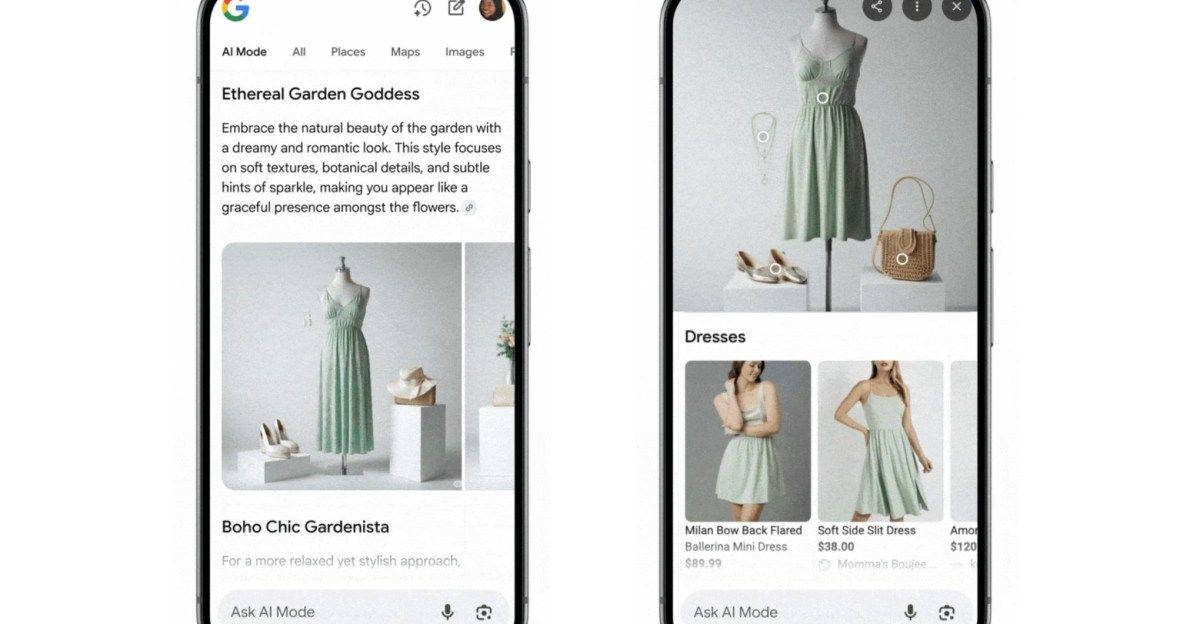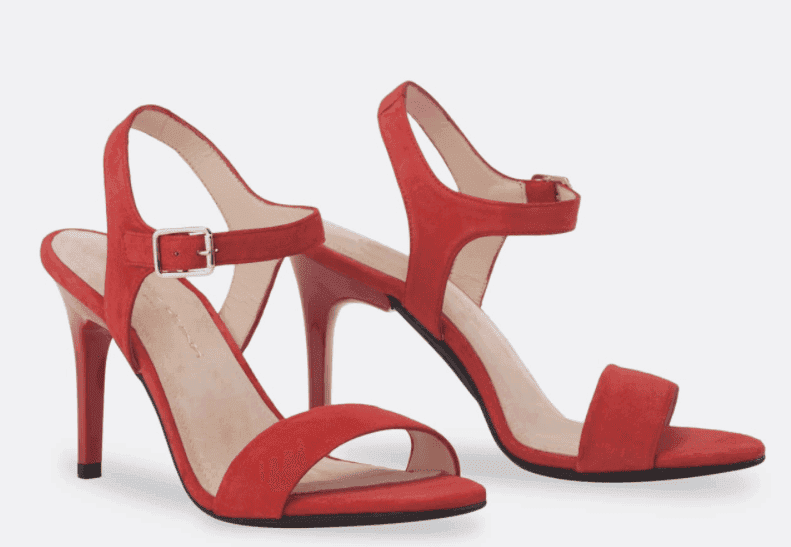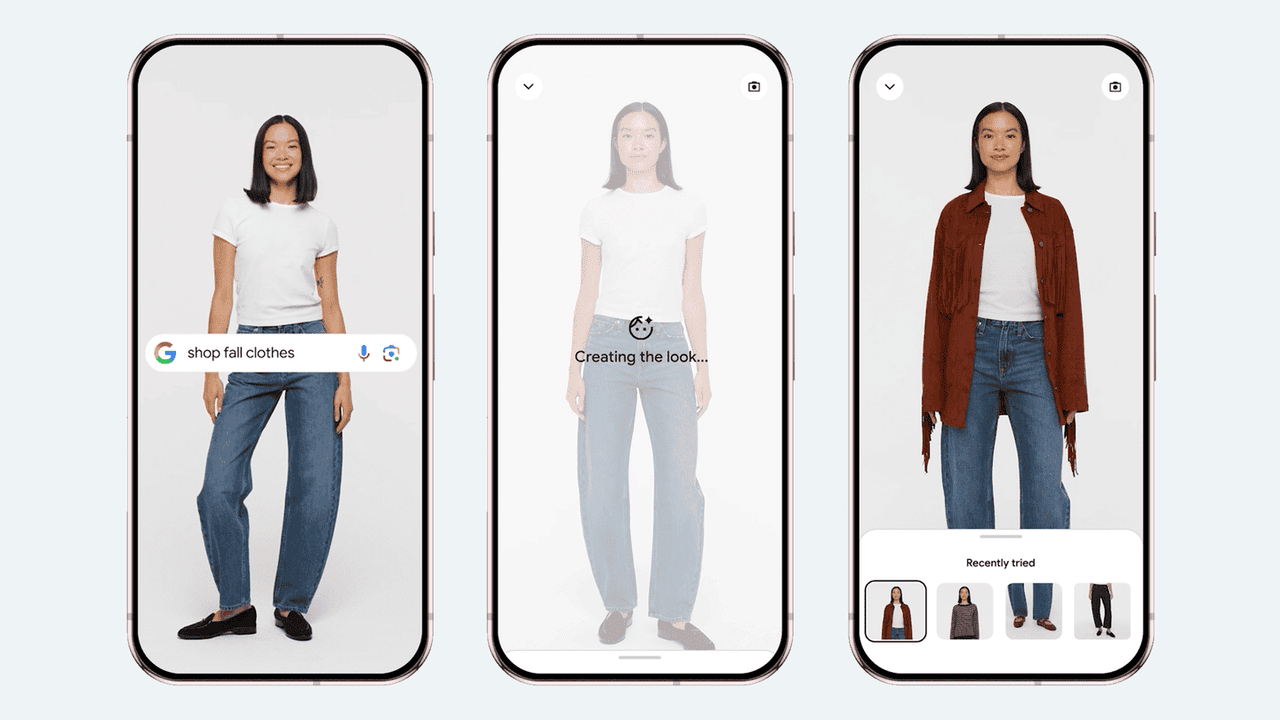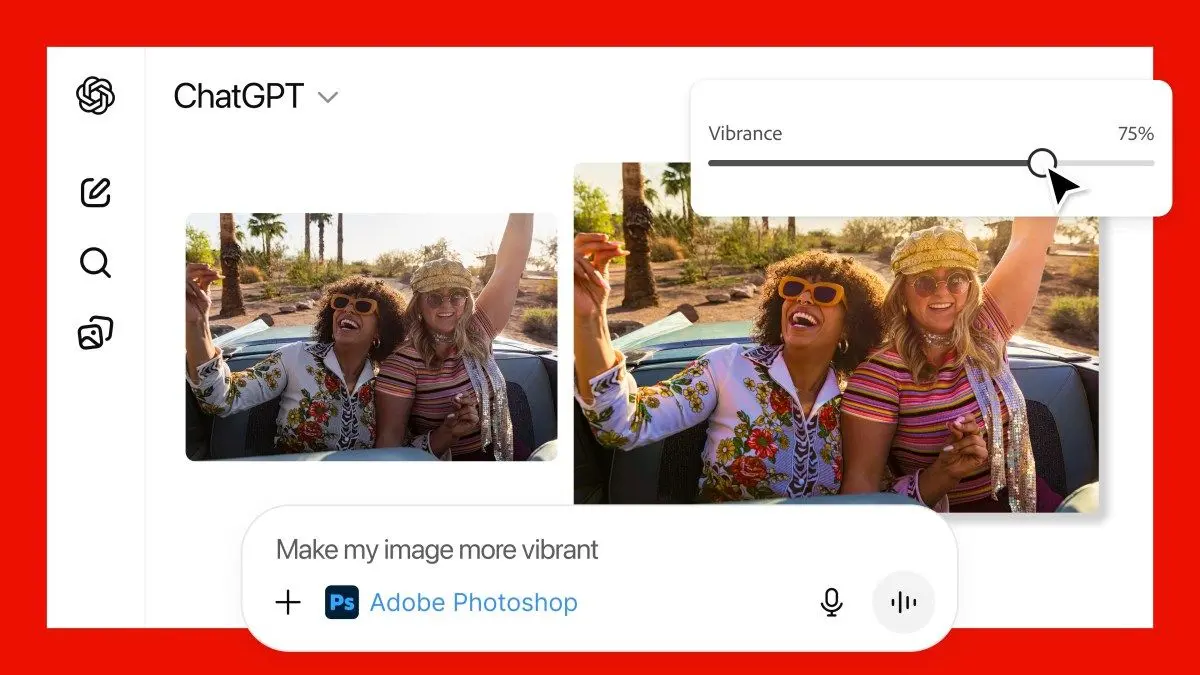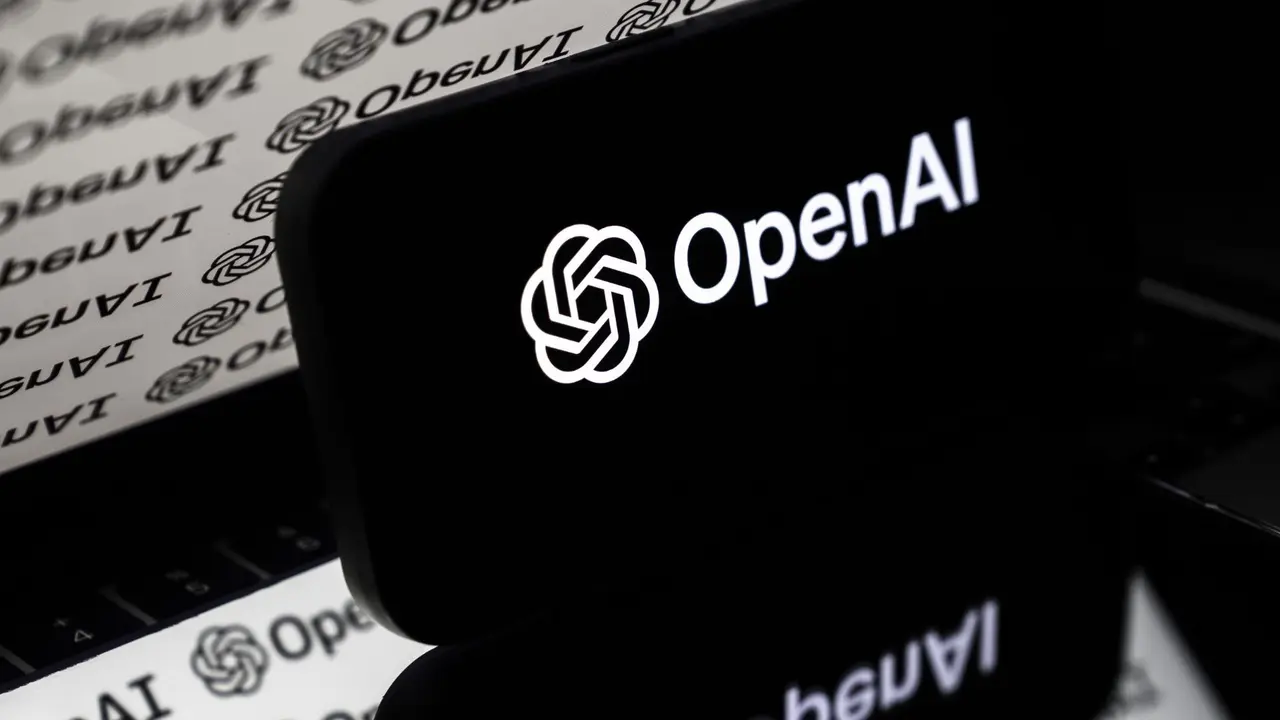Google Unveils AI-Powered 'Try On' Feature for Online Shopping
14 Sources
14 Sources
[1]
I Took Google's New Try On Feature for a Spin -- It Was Fascinating (and Hilarious)
Named a Tech Media Trailblazer by the Consumer Technology Association in 2019, a winner of SPJ NorCal's Excellence in Journalism Awards in 2022 and has three times been a finalist in the LA Press Club's National Arts & Entertainment Journalism Awards. Online shopping often feels like a shot in the dark. It's hard to predict how an outfit a model is wearing will fit me. But at Google I/O on Tuesday, I demoed a new feature called Try On that uses AI to show you how a dress, shirt, skirt or pants will actually look on you. I was surprised, and also incredibly amused. After posing for a quick photo, a Google employee showed me different clothing options in the Shopping tab. I settled on a cute long-sleeved denim jumpsuit, tapped it and uploaded my photo. After about 30 seconds, my real-life floral jumpsuit was replaced by the denim one. The generated image looked impressively real: the sleeves were perfectly tailored, the collar was popped and my pink headscarf (which I was wearing in real life and Gemini thankfully kept on) was neatly tucked in. "It actually looks like I'm wearing it," I said in amazement. "I'm quite impressed." It even added a purse in my right hand, which was a funny touch. Try On is powered by Google's custom image generation model, which can demonstrate how materials drape, fold and stretch on different body types. It's available now in Search Labs, which lets people try out Google Search features before they roll out to the masses. After opting into the feature, you'll see an icon that says "try it on" when browsing for clothes in Google. Upload a full-length photo of yourself (ideally with good lighting and fitted clothing), and watch in wonder as that dress or shirt miraculously appears on you. You can also save the generated image and share it with friends. Of course, I had to have some fun with Try On. As someone who wears hijab, I only wear long sleeves and long pants when I'm out and about. So I decided to test the feature and see what it would do if I picked a pink sleeveless dress. The result was hilarious. It did in fact expose my arms (or what it thinks they look like), and also added some random bracelets and a watch that I was definitely not wearing in real life. Thankfully, it kept my headscarf on (which perfectly matched the pink dress), but that only made for a more hilarious juxtaposition with my exposed AI skin. Well, at least it maintained the dress's accuracy. If you're worried about privacy concerns, my colleague Katelyn Chedraoui reached out to Google to ask about Try On's privacy policies. In response, a Google spokesperson said: "Your uploaded photo is never used beyond trying things on virtually, nor is your photo used for training purposes. It is not shared with other Google products, services or third parties, and you can delete or replace it at any time." So, if you're keen to see how that outfit you would totally wear -- or totally wouldn't -- looks on you, look no further than your phone; no fitting room required. Personally, I look forward to trying on more outfits, both appealing and ridiculous, just for the heck of it.
[2]
I Took Google's New Try On Feature for a Spin, and It Was Fascinating (and Hilarious)
Named a Tech Media Trailblazer by the Consumer Technology Association in 2019, a winner of SPJ NorCal's Excellence in Journalism Awards in 2022 and has three times been a finalist in the LA Press Club's National Arts & Entertainment Journalism Awards. Online shopping often feels like a shot in the dark. It's hard to predict how an outfit a model is wearing will fit me. But at Google I/O on Tuesday, I demoed a new feature called Try On that uses AI to show you how a dress, shirt, skirt or pants will actually look on you. I was surprised, and also incredibly amused. After posing for a quick photo, a Google employee showed me different clothing options in the Shopping tab. I settled on a cute denim long-sleeve jumpsuit, tapped it and uploaded my photo. After about 30 seconds, my real-life floral jumpsuit was replaced by the denim one. The generated image looked impressively real; the sleeves were perfectly tailored, the collar was popped and my pink headscarf (which I was wearing in real life and which Gemini thankfully kept on) was neatly tucked in. "It actually looks like I'm wearing it," I say in amazement. "I'm quite impressed." It even added a purse in my right hand, which was a funny touch. Try On is powered by Google's custom image generation model, which can demonstrate how materials drape, fold and stretch on different body types. It's available now in Search Labs, which lets people try out Google Search features before they roll out to the masses. After opting into the feature, you'll see an icon that says "try it on" when browsing for clothes in Google. Upload a full-length photo of yourself (ideally with good lighting and fitted clothing), and watch in wonder as that dress or shirt miraculously appears on you. You can also save the generated image and share it with friends. Of course, I had to have some fun with Try On. As someone who wears hijab, I only wear long sleeves and long pants when I'm out and about. So I decided to test the feature and see what it would do if I picked a pink sleeveless dress. The result was hilarious. It did in fact expose my arms (or what it thinks they look like), and also added some random bracelets and a watch that I was definitely not wearing in real life. Thankfully, it kept my headscarf on (which perfectly matched the pink dress), but that only made for a more hilarious juxtaposition with my exposed AI skin. Well, at least it maintained the dress' accuracy. If you're worried about privacy concerns, my colleague Katelyn Chedraoui reached out to Google to ask about Try On's privacy policies. In response, a Google spokesperson said: "Your uploaded photo is never used beyond trying things on virtually, nor is your photo used for training purposes. It is not shared with other Google products, services or third parties, and you can delete or replace it at any time." So, if you're keen to see how that outfit you would totally wear -- or totally wouldn't -- looks on you, look no further than your phone; no fitting room required. Personally, I look forward to trying on more outfits, both appealing and ridiculous, just for the heck of it.
[3]
This Is What Surprised Me Most About the Google I/O AI Shopping Feature
An AI fashion tool was not on my Google I/O bucket list. At Google's annual I/O developers conference, the company introduced a number of Gemini AI updates, many of which are coming to Search and, notably, to our online shopping experiences. The new AI shopping feature lets you virtually "try on" different articles of clothing by using a photo of your body and imagining what it may look like on you. Google built a custom image generation model to power its new feature. It's a simple idea: Google's AI takes your input image of your body and the input image of the garment, and the AI combines them. The actual process behind it is more complicated, surely. But in the live demo, it seemed to work flawlessly. The virtual try on feature is available today in the US, with more visual shopping and AI agentic updates coming soon. I was very intrigued when I saw the live demo. I shop online for nearly everything I need, and I have been fooled many times by mis-imagining how clothing I see on models would look on me. But I'm an AI reporter, and I spend a lot of time worrying about the privacy implications of image and video tools, so I was skeptical, too. Read more: Everything Announced at Google I/O 2025 I reached out to Google after the keynote to ask about the privacy policies around this new feature. A Google spokesperson said: "Your uploaded photo is never used beyond trying things on virtually, nor is your photo used for training purposes. It is not shared with other Google products, services or third parties, and you can delete or replace it at any time." I was jaw-droppingly, pleasantly surprised by this. In the age of AI, tech companies are typically so data-hungry that a source of data like this seemed like a no-brainer for Google to use. Google spent a decent chunk of time during I/O showing off its new AI image and video tools, and human-generated photos like these would be useful for future model improvements. Tech and fashion companies have been trying to work at these problem for years -- my CNET colleague Katie Collins wrote about one dress-sizing app all the way back in 2012, and Amazon's integrated AI for its fashion sales in recent years, too. This fashion model, as Vidhya Srinivasan, Google's vice president and general manager of ads and commerce, called it during the keynote, has "a deep understanding of the human body." We'll have to test it out to see if it really works for all body types and sizes. AI image generators, especially early ones from Google, aren't always great when it comes to diversity. But I'm willing to give Google a chance since it won't use my pictures to automatically train its AI models. As much as I want to believe Google has given us a 2025 version of Cher's closet from Clueless, I'm still a little skeptical. There's no guarantee that the AI version of yourself Google generates will actually reflect how the clothing looks on you in real life. But maybe this is a potentially good use of AI, instead of filling the internet with slop.
[4]
My Jaw Dropped When Google Told Me How Its New AI Shopping Feature Handles Privacy
Katelyn is a writer with CNET covering social media, AI and online services. She graduated from the University of North Carolina at Chapel Hill with a degree in media and journalism. You can often find her with a novel and an iced coffee during her time off. An AI fashion tool was not on my Google I/O bucket list. At Google's annual I/O developers conference, the company introduced a number of Gemini AI updates, many of which are coming to Search and, notably, to our online shopping experiences. The new AI shopping feature lets you virtually "try on" different articles of clothing by using a photo of your body and imagining what it may look like on you. Google built a custom image-generation model to power its new feature. It's a simple idea: Google's AI takes the input image of your body and the input image of the garment and combines them. The actual process behind it is surely more complicated. But in the live demo, it seemed to work flawlessly. The virtual try-on feature is available today in the US, with more visual shopping and AI-agentic updates coming soon. I was very intrigued when I saw the live demo. I shop online for nearly everything I need, and I have been fooled many times by misimagining how clothing I see on models would look on me. But I'm an AI reporter, and I spend a lot of time worrying about the privacy implications of image and video tools, so I was skeptical, too. Read more: Everything Announced at Google I/O 2025 I contacted Google after the keynote to ask about the privacy policies around this new feature. A Google spokesperson said, "Your uploaded photo is never used beyond trying things on virtually, nor is your photo used for training purposes. It is not shared with other Google products, services or third parties, and you can delete or replace it at any time." I was jaw-droppingly, but pleasantly surprised by this. In the age of AI, tech companies are typically so data-hungry that a source of data like this seemed like a no-brainer for Google to use. Google spent a decent chunk of time during I/O showing off its new AI image and video tools, and human-generated photos like these would be useful for future model improvements. Tech and fashion companies have been trying to work on this problem for years -- my CNET colleague Katie Collins wrote about one dress-sizing app all the way back in 2012, and Amazon's integrated AI for its fashion sales in recent years, too. This fashion model, as Vidhya Srinivasan, Google's vice president and general manager of ads and commerce, called it during the keynote, has "a deep understanding of the human body." We'll have to test it out to see if it really works for all body types and sizes. AI image generators, especially early ones from Google, aren't always great when it comes to diversity. But I'm willing to give Google a chance since it states it won't use my pictures to automatically train its AI models. As much as I want to believe Google has given us a 2025 version of Cher's closet from Clueless, I'm still a little skeptical. There's no guarantee that the AI version of yourself Google generates will actually reflect how the clothing looks on you in real life. But maybe this is a potentially good use of AI, instead of filling the internet with slop.
[5]
3 ways Google's AI Mode will change how you shop online - if it works
Online shopping has never been perfect. If I'm online scouting for a good deal on a pair of shoes, I have to sort through several options, sizes, colors, and price points to find what I want. That takes time. And if I want to buy the shoes at a discount, I have to wait several weeks or months and come back when the price drops. Also: Everything announced at Google I/O 2025: Gemini, Search, Android XR, and more At Google's annual developer event, Google IO, the tech giant is debuting an AI-powered solution to online shoppers' problems in the form of AI Mode. AI Mode offers online shoppers several options for finding exactly what they want, virtually trying on the clothing before they buy, and tracking prices to buy when a product is at its lowest. AI Mode will fundamentally shake up how people search for products and shop online. Here's how. Gemini combines forces with Google's Shopping Graph, now with more than 50 billion product listings sourced from big-name brands and indie shops to elevate your browsing and shopping experience. Two billion listings are refreshed every hour to keep the results relevant and updated, so shoppers will get current pricing, the most recent discounts, and availability. Also: 8 best AI features and tools revealed at Google I/O 2025 When a shopper searches for a product, they type what they're looking for and the occasion they'll be using the product for, and Google scouts options that fit those descriptors. In a press release, Google provides the example of a "cute travel bag" for a Portland, Oregon, vacation. AI Mode initiates a "query fan-out" to run several simultaneous searches and investigate a travel bag with pockets that meets the conditions or fits underneath an airplane seat. Additionally, a panel will update with new brands and options as you search. US users can expect AI Mode for shopping to roll out in the coming months. Set the size, color, and desired price point on a product, and keep an eye on its price with Google's new price-tracking feature. Once you've set up price-tracking on a product, Google will send you price-drop notifications to buy when the product is discounted. Additionally, Google will add the product to your cart and securely check out with Google Pay once the price drops to your desired range. Also: Google's new AI tool can track products and buy for you when the price drops Like AI Mode, this feature will also roll out in the coming months. Don't know how that bright yellow pencil skirt will look on you once it arrives in the mail? You can now try it on virtually with Google's new virtual try-on technology that's powered by a custom image generation model made for fashion that accounts for body type, fabrics, and the overall nuances of clothing. Upload a photo of yourself and start trying on clothing from Google's Shopping Graph, and if you need a second opinion, you can share the photos with friends. The try-on tech is available today in Search Labs in the US. Get the morning's top stories in your inbox each day with our Tech Today newsletter.
[6]
Google's new AI shopping tool just changed the way we shop online - here's why
In recent years, Google Search's shopping features have evolved to make Search a one-stop shop for consumers searching for specific products, deals, and retailers. Shoppers on a budget can scour Search's Shopping tab during major sale events to see which retailer offered the best deal and where. Also: Everything Google just announced at I/O 2025: Gemini upgrades, AI Search, Android XR, and more But often, consumers miss out on a product's most productive discount, paying more later because they don't want to wait again. During this year's Google I/O developer conference, Google aims to solve this problem with AI. Shopping in Google's new AI Mode integrates Gemini's capabilities into Google's existing online shopping features, allowing consumers to use conversational phrases to find the perfect product. Additionally, once you've found the correct product, you can set which size, color, and price comprise your perfect discount, and once that deal exists, Google AI can purchase it for you. Also: 8 most exciting AI features and tools revealed at Google I/O 2025 For example, perhaps you want to buy the Google Pixel Buds Pro 2 earbuds in the color Porcelain, but you want to wait until they're $189. Input those details in the "track price" tab, and once that item is on sale, Google AI will buy it for you on the retailer's website using your Google Pay credentials. According to Google, this feature's availability is limited to the US at launch and will be accessible to users on a rolling basis in the coming months. Get the morning's top stories in your inbox each day with our Tech Today newsletter.
[7]
I Tried on Clothes With Google AI, and It Was Really Weird
Quick Links What is Google "Try On"? Let's Get Dressed Closing Thoughts If there's one thing we can all agree on, it's that trying on clothes is a pain. However, as annoying as it may be, it's still something that's crucially missing from online shopping. Google is attempting to combine online shopping with trying on clothes in real life, and I gave it a try. What is Google "Try On"? The feature is called "Try On" and, as you would expect, it's powered by AI. It builds on Google's previous Shopping feature that allows you to see clothes visualized on a wide range of skin tones and body types. But with "Try it On," you get to be the model, and all it takes is a photo. To try for yourself, you'll need to enable "Try On," which is currently an experiment, from the Search Labs. You can do this by opening the Google app on your phone and tapping the beaker icon in the top corner. Opt in to the feature and then tap "Try things on." Google will guide you through uploading a photo of your full body. Once you have a photo uploaded, it's just a matter of finding clothes with the "Try it on" button in Google Shopping. You can easily cycle through the different outfits you've tried on and share the photos with friends to get their input. The whole process is pretty painless, but how does it look? Let's Get Dressed To ease you into things, Google has provided a bunch of generic clothing organized into "Womenswear" and "Menswear." I got started with full top-to-bottom denim coveralls. In the gallery below, you can see the outfit and my before-and-after photos. Close For the most part, I'm very impressed with the result. I intentionally used a photo with hands in my pocket to make it more difficult, and it handled it well. There's some weirdness going on with my face that wasn't in the original photo, though. Let's keep trying. Close This one was just supposed to be linen cargo pants, but I realized it always changes your entire outfit -- which is one of my small issues. But again, I'm really impressed with the result. The skin on my chest that wasn't in the original photo matches perfectly. My hands are flawlessly in my pockets again, too. Close Now, we're upping the difficulty level this time. I'm trying on shorts, but my legs are not visible in the original photo. The accuracy for this one really blows me away. I would swear that those are my real legs, which is a bit disconcerting, to be honest. It gives me "uncanny valley" vibes despite looking totally realistic. As mentioned, these have all been generic outfits provided by Google to test the feature, but the real magic comes with clothing you can actually purchase. All you have to do is search for something in Google Shopping and look for the "Try it on" button. Close As you can see, the AI struggled a bit more with these. This is a Detroit Tigers pullover that looks mostly okay until you notice the text on the front is a jumbled mess. It also gave me new pants and shoes, which I did not ask for. Close It did a pretty good job with this flannel shirt, especially with the skin around my neck and chest again. Interestingly, it didn't roll up the sleeves like they appear in the product photo. The same thing is happening with the rest of my outfit, though. Where did that big belt buckle come from? Close For the last one, I tried another pair of shorts. Once again, I am a bit spooked by how real those legs look. But my main gripe is that I don't like how it changes my entire outfit every time. What if I wanted to see how those shorts looked with the shirt I was wearing? Why can't I do that? Closing Thoughts Not everything that I searched for was available to try on. Along with many shirts and pants I found, I wasn't able to try on any caps, beanies, or full-body costumes. Google did say it's for "shirts, pants, skirts, and dresses," but it didn't mention if they're partnering with certain brands or stores. I'm not sure how it determines whether you can try something on or not. For the most part, I'm impressed with "Try On," and I can see myself using it in the future. If you can't tell from my photos, I'm a tall person, which makes it hard to find my size in physical stores. So, what I often do is buy multiples online and return the ones I don't like. This could potentially save me from some of that hassle. It won't tell me which things will fit best, but I'll get an idea of how it will look on me. Right now, this seems to be presenting the best-case scenario -- what the clothes with look like if they fit you perfectly. Clothes often don't fit perfectly, though, so sizing seems like a logical next step for something like this. I can imagine a not-too-distant future where you can cycle through sizes to see how they'd fit. Nothing will ever replace the feeling of physical clothes on your body, but getting some digital help is nice.
[8]
I tried Google's new AI try-on feature, and it's given me some new fashion ideas
Google has rolled out a new AI-powered shopping feature to help you figure out what the clothes you are interested in buying might look like when you wear them. It's dubbed "try it on" and it's available right now in the US through Google Search Labs. To get started, you just need to switch it on in the lab. Then, you upload a full-length photo of yourself and start looking for clothes in the Google Shopping tab. When you click on an image of some outfit from the search results, you'll see a little "try it on" button in the middle of the enlarged version of the outfit in the right-hand panel. One click and about ten seconds later, you'll see yourself wearing the outfit. It may not always be a perfect illusion, but you'll at least get a sense of what it would look like on you. Google claims the whole thing runs on a model trained to see the relationship between your body and clothing. The AI can, therefore, realistically drape, stretch, and bunch material across a variety of body types. The feature doesn't work with every piece of clothing you might see, or even every type of outfit. The clothing retailer has to opt into the program, and Google said it only works for shirts, pants, dresses, and skirts. I did notice that costumes and swimwear both had no usable images, but I could put shorts on myself, and costumes that looked enough like regular clothes were usable. The AI also didn't seem to have an issue with jackets and coats as categories. For instance, on Google Shopping, I found replicas of the outfits Elvis wore for his 1966 comeback and one of his jumpsuits from the 1970s. With a couple of clicks, I could imagine myself dressed as the King in different eras. It even changed my shoes in the all-black suit. I'd always wondered if I could pull off either look. The images are shareable, and you can save or send them to others from the Google mobile app and see how much of an Elvis your friends think you are. The details that the AI changes to make the photos work are impressive. I used the AI to try on a fun summer look and the closest to a superhero costume I could try. The original photo is me in a suit and jacket with a bowtie and black dress shoes. But the shoes and socks on both AI-generated images not only match what was in the search result, but they're shaped to my stance and size. Plus, despite wearing long sleeves and pants, the AI found a way to show some of my arms and legs. The color matches reality, but its imperfections are noticeable to me. My legs look too skinny in both, like the AI thinks I skipped leg day, and my legs in the shorts have not been that hairless since I turned 13. Imperfections aside, it does feel like this will be a major part of the next era of e-commerce. The awkward guessing of whether a color or cut works for your skin tone and build might be easier to resolve. I wouldn't say it can make up for trying them on in real life, especially when it comes to sizing and comfort, but as a digital version of holding an outfit up against you while you look in a mirror, it's pretty good. Uncanny as some of the resulting images are, I think this will be a popular feature for Google Shopping. I'd expect it to be heavily imitated by rivals in AI development and online retail, where it isn't already. I particularly like how the AI lets you see how you'd look in more outlandish or bold looks you might hesitate to try on at a store. For example, the paisley jacket and striped pants on the left or the swallowtail jacket and waistcoat with Victorian trousers on the right. I'd hesitate to order either look and would almost certainly plan on returning one or both of them even before they arrive. Returns are a plague on online retailers and waste tons of packaging and other resources. But if Google shows us how we'd look in clothes before we buy them, it could chip away at return rates; retailers will race to sign up for the program. It could also open the door to more personalized style advice from AI. You could soon have an AI personal dresser, ready to give you a virtual fit check and suggest your next look, even if it isn't something Elvis would have worn.
[9]
I tried Google's new 'Try it on' AI shopping tool. I'm equally impressed and mortified.
Credit: Ian Moore / Mashable Composite; lupengyu / Moment / Getty / Google At Google I/O 2025, the tech company announced a ton of new AI features, and one of the most interesting is a virtual clothing try-on tool. The Google Shopping "Try it on" feature lets users upload a photo of themselves and then virtually try on clothes, basically the IRL version of the Clueless closet millennials have been dreaming about since 1995. Or, as Mashable Shopping Reporter Haley Henschel put it, "Google's latest shopping feature makes Cher Horowitz's computerized closet a reality." Almost as soon as the feature was released, users started trying to "jailbreak" the tool, which is becoming a fun little tradition for tech writers every time a new AI model or tool is released. On Friday, The Atlantic reported that "Google's new AI shopping tool appears eager to give J.D. Vance breasts." Hilarious, right? What's less hilarious -- the same tool will also generate breasts for photos of underage users, again per The Atlantic. I decided to give the "Try it on" feature a test spin, and I'll explore the good, the bad, and the mortifying below. As a shopping tool, I have to say I'm impressed. The virtual try-on feature is one of the free AI tools released by Google this week, and users can sign up to participate now. Officially, this product is part of Google Labs, where users can test experimental AI tools. Signing up is simple: Purely as a tool for trying on clothes, the new virtual try-on experience is pretty damn impressive. The tool uses a custom image generation model trained for fashion, per Google. I'm always skeptical of new AI tools until I've tried them myself. I also care about my own personal style and consider myself up-to-date on men's fashion trends, so I wasn't sure what to expect here. However, the tool does work as advertised. In a flashy I/O presentation, Google showed models seamlessly trying on one outfit after the next, and while the actual tool is a little slower (it takes about 15 seconds to generate an image), the actual product experience is very similar to the demo. To show you what I mean, let's compare some selfies I recently took on a trip to Banana Republic here in New York City to the AI photos generated by Google for the same clothes. For reference, here's the original photo I uploaded (and remember that I'm a Tech Editor, not a fashion model): In this first photo, I'm wearing a blue cashmere polo, and the AI image looks more or less like the real one taken in the Banana Republic dressing room: I found the AI shopping tool came pretty close to capturing the overall fit and style of the shirts. It even changed my pants and shoes to better match the product. If anything, the virtual try-on tool errs on the side of making me slimmer than I am IRL. In this photo, Google added a necklace around my neck that I would never wear in real life, and the AI-generated shirt is a little more slim-cut than it's supposed to be, but in general the overall style is accurate. While the images are generating, you see a message that says: "AI images may include mistakes. Fit and appearance won't be exact." But for an experimental tool, it's surprisingly on point. People have been hoping for a tool like this for decades, and thanks to the age of artificial intelligence, we finally have one. Of course, not all of the mistakes made by this tool are so flattering... Here's where things get interesting. In The Atlantic piece I mentioned before, the authors found that if you asked the tool to generate an image of a revealing dress or top, it would sometimes generate or augment breasts in the original photo. This is particularly likely to happen with women's clothing, for reasons that should be obvious. When I used this tool with a pink midi dress, the results were mortifyingly accurate. I bet that's pretty much exactly what I would look like wearing that particular low-cut midi dress. I'll spare you from the actual image, but to imagine me in the dress, Google had to digitally remove most of my shirt and picture me with chest hair. Again, I'm surprised by how accurate the results were. Now, when I "tried on" a pink women's sweater, Google did give me some extra padding in the breast section, but I've also been open about the fact that that's not entirely Google's fault in my case. Thankfully, this feature was not available for lingerie. What can be done about these problems by Google? I'm not sure. Men have every right to wear cute pink midi dresses, and Google can hardly prohibit users from choosing cross-gender clothing. I wouldn't be surprised if Google eventually removes the tool from any product that shows too much skin. While The Atlantic criticizes Google for altering images of them when they were underage, they were the ones who uploaded the images, and in violation of Google's own safety policies. And I suspect the offending results would also be the same with almost any AI image generator. In a statement to Mashable, a Google spokesperson said, "We have strong protections, including blocking sensitive apparel categories and preventing the upload of images of clearly identifiable minors. As with all image generation, it won't always get it right, and we'll continue to improve the experience in Labs." Could people abuse the virtual try-on tool to cyberbully their peers or create deepfakes of celebrities? Theoretically, yes. But that's a problem inherent to AI in general, not this specific tool. In its safety guidelines for this product, Google bans two categories of images, in addition to its general AI content guidelines: Again, you can try out this tool at Google Search Labs. I reached out to Google for comment, and I'll update this story if I hear back.
[10]
Google Shopping adds new AI tools, including virtual try on with photos
Why it matters: AI is reshaping how we shop. It's going beyond recommending products and helping consumers visualize and buy products. Driving the news: Google unveiled a series of new AI features at Tuesday's event. Google AI Mode Zoom in: Starting today, Google is starting to roll out AI Mode -- a chat-like version of search -- but shopping features will be added in the coming months. By the numbers: Shopping Graph has more than 50 billion product listings, from global retailers to local shops, and includes details like reviews, prices, color options and availability. Google Try It On virtual dressing room State of play: Google first introduced a virtual try-on tool in 2022 but the technology used AI models where consumers selected the one that best matched their body type. What they're saying: "Our try-on experience works with your photo. It's not some pre-captured image or a model that doesn't look like you," Vidhya Srinivasan, Google's vice president of advertising and commerce, said during a live demo at Tuesday's event. How it works: Go to Google Search Labs and opt into the "try on" experiment that went live Tuesday. More from Axios:
[11]
Shop with AI Mode, use AI to buy and try clothes on yourself virtually
Shopping comes with lots of questions: How do I choose a pair of hiking boots? Will these pants look good on me? If I buy this today, will the price just drop tomorrow? Today we introduced our new shopping experience in AI Mode with inspiring visuals, smart guidance and reliable product data. We're even giving shoppers a virtual dressing room and a new agentic checkout experience, so you can act quickly to make a purchase when the price is right for you. Our new AI Mode shopping experience brings together Gemini capabilities with our Shopping Graph to help you browse for inspiration, think through considerations and narrow down products. The Shopping Graph now has more than 50 billion product listings, from global retailers to local mom and pop shops, each with details like reviews, prices, color options and availability. And you know you're getting fresh and accurate information you can trust, because every hour more than 2 billion of those product listings are refreshed on Google.
[12]
Google's Making it Easier to Buy Clothes that Will Fit You - Phandroid
In addition to several updates to its many AI software projects and products, Google today announced an overhaul of its online shopping experience which now works alongside its "AI Mode" for Search, providing users with a more intuitive and efficient way to shop for products. READ: Google's New All-in-One AI Subscription Service Comes with a Hefty Fee With that in mind, the new feature uses Gemini and Google's Shopping Graph (which covers 50 billion products) for visual inspiration, smart guidance, and accurate product data. One major feature includes a virtual dressing room called "Try it on" where users can try on billions of apparel items on themselves by uploading a photo, which is powered by a new custom image generation model and is able to understand the nuances of clothing on different body sizes and types. Users can also access an "agentic checkout" that allows for price-tracking and can even automatically complete purchases when their desired price is met. AI Mode can also understand nuanced requests -- like finding a "cute travel bag" suitable for rainy weather -- by performing multiple simultaneous searches. As for availability, Google says that the new shopping tools are rolling out in the U.S. in the coming months.
[13]
Google's "Try It On" Can Help You See How Clothes Fit Before You Buy Them
To use it, you need to go to Google app > Labs option > scroll down to Try things on virtually. Has this ever happened to you, where you spot a dress or a cool jacket online, but can't tell whether it would look good on you? Well, Google has come out with a helpful solution called "Try it on", and people are already saying that it will change the way you shop forever. Try it on is a new feature that is part of the company's new AI Mode, which was introduced in yesterday's Google I/O event. The feature lets you visualize how different items of clothing would look on you, and the results look extremely convincing, unlike those cardboard cut-out virtual closets that some shopping apps feature these days. To achieve this convincing look, Google is using a custom Imagen model that understands the dimensions and depth of your body. It also understands different textures of the cloth and how it behaves based on the product images. The model combines these two factors to generate a result that makes you look like you're wearing that $1,000 Louis Vuitton dress. "Try it on" is a part of AI Mode, which is currently limited to the U.S. audience. So you'll need a VPN to use it if you are not native to the region. With this piece of information out of the way, here's how you can use it. You can try out more looks from Google's Shopping catalog. However, we noticed that the feature doesn't work with some items. It is weird, but some piece of clothing will show an option for Try it on and some won't. The feature has just come out yesterday, and people over on X are already going gaga over this feature. They are checking out the feature for the first time, and some are loving it. To the point that they already want it to be a regular part of their lives now. Even popular tech YouTuber MKBHD shared an X post describing how this feature works and how it can benefit you. As you can try out clothes and see how they fit you before you pull the trigger and buy it. However, he also pointed out a flaw that you don't necessarily have to use your own photo. You can use anyone else's and then dress them up in compromising clothes to probably bully others. Another problem with Try it on is the privacy factor. The feature requires you to upload a complete image of yourself, which stays within the tool, so you don't have to repeat the process again and again. While these issues are concerning, it goes without saying that this is a revolutionary feature with huge potential. Google should make it a default thing with images so we can try out any piece of clothing without much hassle. Even other apps should be able to integrate this feature. What are your thoughts on this new Try it out feature? Let us know in the comments below.
[14]
Google I/O 2025: AI Shopping mode with virtual try-on, price tracking, agentic checkout
At the I/O 2025, Google revealed a new AI-driven shopping experience designed to help users find products easily with smart tools, accurate data, and a virtual try-on feature. Google introduced AI Mode for shopping, combining advanced AI from Gemini with the Shopping Graph. This update offers shoppers personalized inspiration, detailed product info, and a streamlined checkout process. AI Mode Shopping: The AI Mode combines Gemini's capabilities with Google's Shopping Graph, which contains more than 50 billion product listings from retailers around the world. These listings feature reviews, prices, colors, and availability, refreshed hourly with more than 2 billion updates daily. Personalized Browsing: When searching, for example, "cute travel bag," AI Mode presents a visually rich panel of images and options tailored to user preferences. Contextual Filters: AI Mode can refine results based on specific needs, such as bags suitable for rainy trips to Portland, Oregon. It runs multiple searches simultaneously to suggest products matching these conditions, like waterproof bags with easy-to-reach pockets. Agentic Checkout: Users can tap "track price" to set their size, color, and budget. The system sends price drop alerts and allows quick purchase confirmation. Google completes the transaction securely via Google Pay on the merchant's site. Virtual Try-On: Shoppers can upload a photo to virtually try billions of clothing items using a custom image generation model. This model understands body shapes and clothing behavior (folding, stretching, draping) to create realistic try-on images. Try-On Access: Available now in Search Labs, users shopping for shirts, pants, skirts, and dresses can tap a "try it on" icon to see how clothes fit their photo. Looks can be saved or shared. Lilian Rincon, Vice President of Product Management at Google, said the new features aim to help shoppers act quickly when prices match their budgets. She also emphasized the scale and accuracy of the Shopping Graph and how AI Mode aids users in making better buying decisions through inspiration and smart filtering.
Share
Share
Copy Link
Google introduces an AI-powered 'Try On' feature for online shopping, allowing users to virtually try on clothes using their own photos, with a focus on privacy and user experience.
Google Introduces AI-Powered 'Try On' Feature
Google has unveiled a groundbreaking AI-powered feature called 'Try On' at its annual I/O developers conference, aiming to transform the online shopping experience. This innovative tool allows users to virtually try on clothing items using their own photos, potentially solving a long-standing challenge in e-commerce
1
.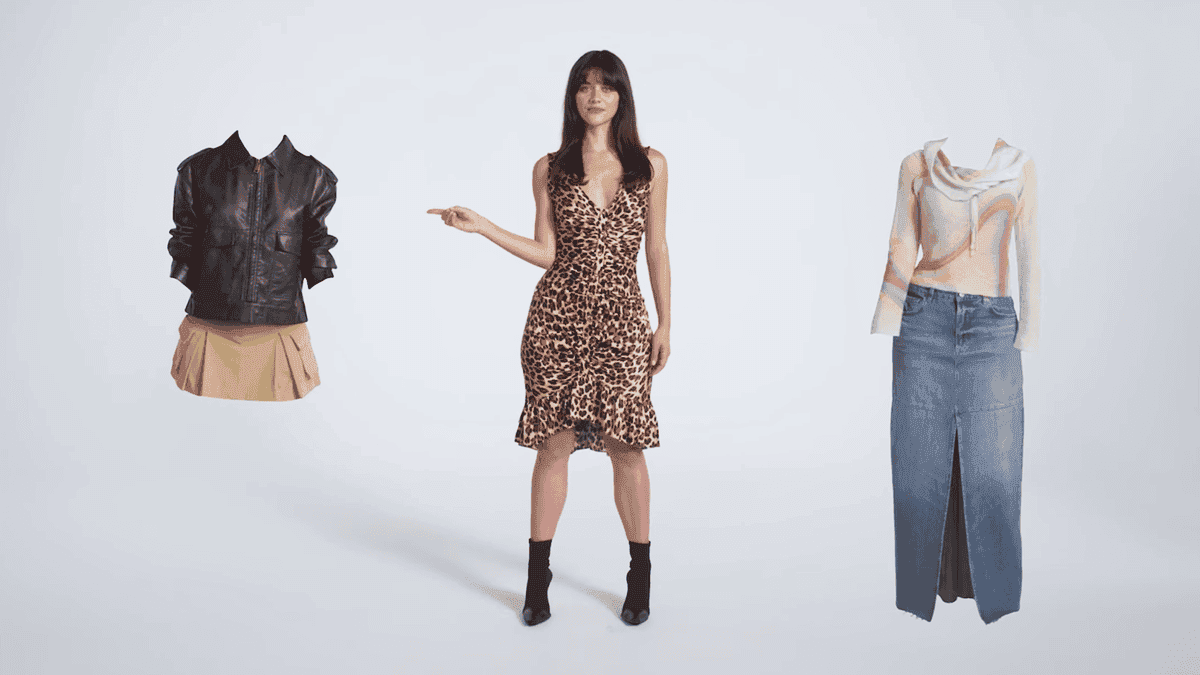
Source: TechRadar
How 'Try On' Works
The 'Try On' feature is powered by Google's custom image generation model, which demonstrates an impressive ability to simulate how materials drape, fold, and stretch on different body types. Users can upload a full-length photo of themselves, ideally with good lighting and fitted clothing, and then select clothing items to virtually try on
2
.In a live demonstration, the AI accurately replaced a user's real-life outfit with a selected denim jumpsuit, maintaining details such as the user's headscarf and even adding accessories like a purse. The generated images appeared remarkably realistic, with well-tailored sleeves and accurate collar placement
1
.
Source: Beebom
Privacy Concerns Addressed
Given the sensitive nature of personal photos, Google has taken steps to address privacy concerns. According to a Google spokesperson, "Your uploaded photo is never used beyond trying things on virtually, nor is your photo used for training purposes. It is not shared with other Google products, services or third parties, and you can delete or replace it at any time"
3
.This commitment to privacy has been met with surprise and approval from tech reporters, who note that it's unusual for AI companies to forgo using such valuable data for model improvements
4
.Broader AI Shopping Features
The 'Try On' feature is part of a larger AI Mode for shopping introduced by Google. This mode includes enhanced product search capabilities and price tracking features. Users can set preferences for size, color, and price, and receive notifications when desired items are discounted
5
.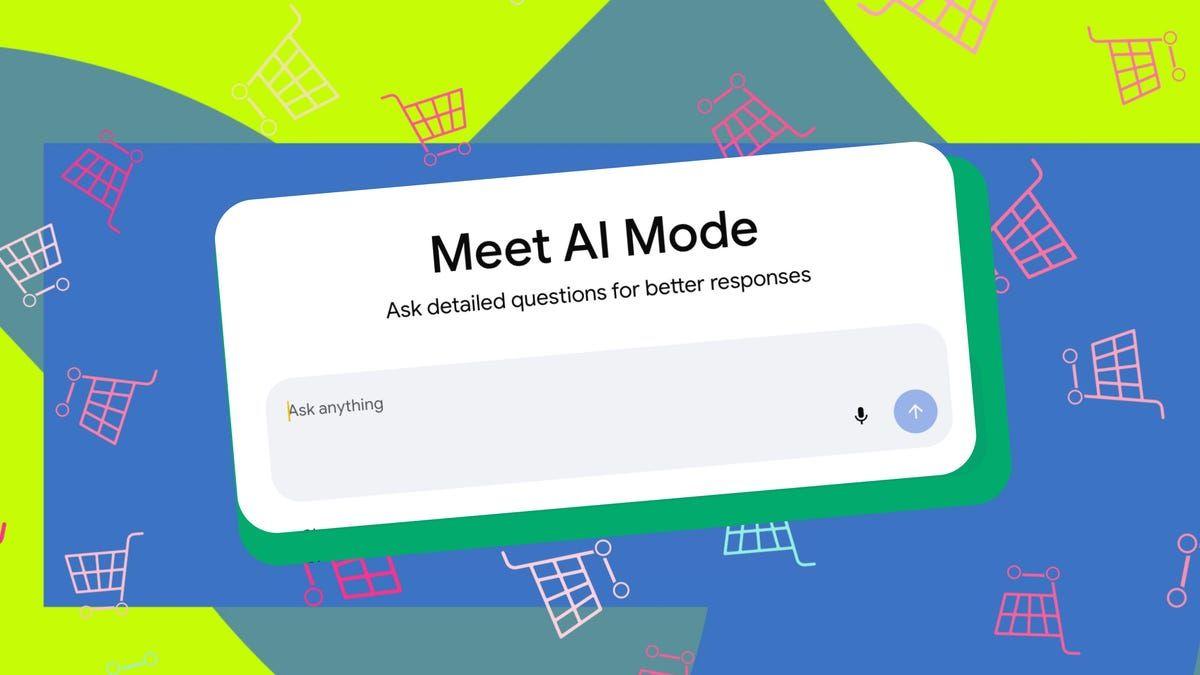
Source: ZDNet
Google's Shopping Graph, which powers these features, now includes over 50 billion product listings from various brands and shops, with 2 billion listings refreshed hourly to ensure up-to-date information on pricing, discounts, and availability
5
.Related Stories
Potential Impact and Limitations
While the 'Try On' feature shows promise in addressing common online shopping challenges, some skepticism remains. There's no guarantee that the AI-generated images will perfectly reflect how clothing looks in real life. Additionally, the effectiveness of the tool across diverse body types and sizes remains to be seen
4
.Availability and Future Developments
The 'Try On' feature is currently available in Search Labs for US users. Other AI shopping features, including enhanced search capabilities and price tracking, are expected to roll out in the coming months
5
.References
Summarized by
Navi
Related Stories
Recent Highlights
1
AI Chatbots Sway Voters More Effectively Than Traditional Political Ads, New Studies Reveal
Science and Research

2
Google AI glasses set to launch in 2026 with Gemini and Android XR across multiple partners
Technology
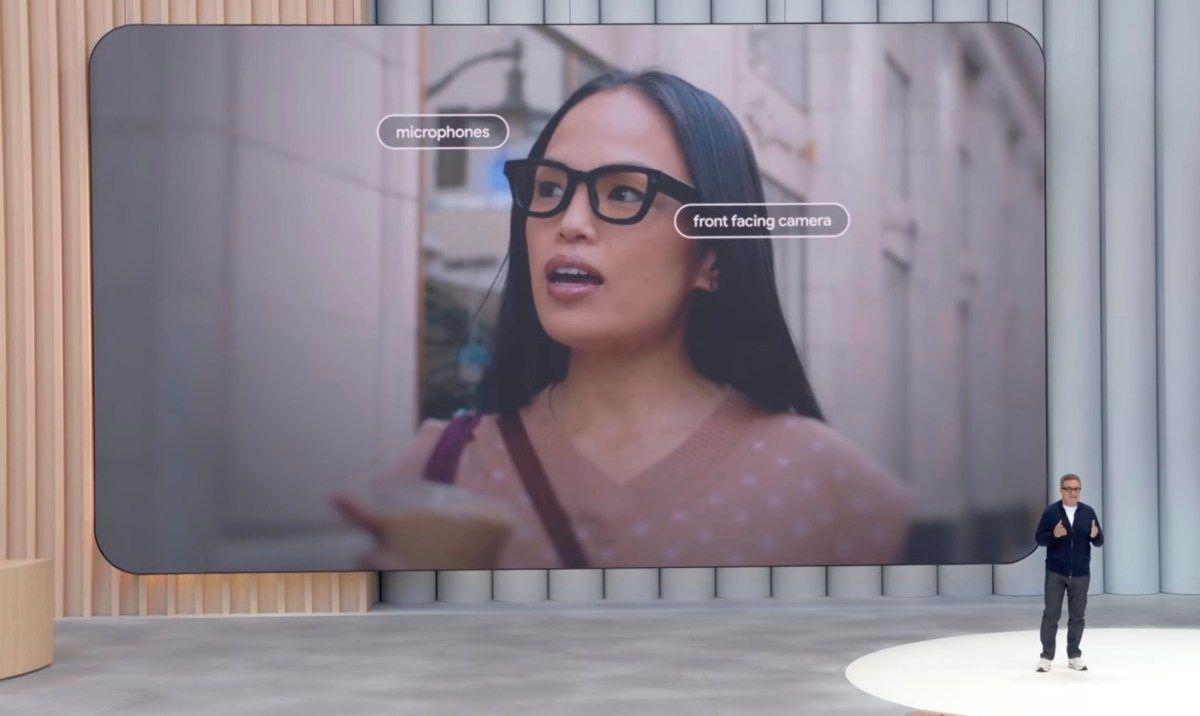
3
EU Launches Antitrust Probe Into Google's AI Training Practices and Content Usage
Policy and Regulation

